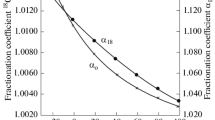Summary
Working in the ampere range the hollow cathode is suitable for the quantitative analysis of metals and glasses because of the good standard deviation (±2 to 6%) and limit of sensibility (some ppm). The characteristics of the discharge (especially the relations of current, pressure and intensity) can be explained by ideas of plasma physics. The ablation of the cathode materials is directly proportional to the square of the output and inversely proportional to the pressure. The constant depends only on the cathode material and gases.
Zusammenfassung
Die Hohlkathode erwies sich im Ampère-Bereich für die quantitative Analyse von Metallen und Gläsern wegen der guten Reproduzierbarkeit (±2–6%) und guten Nachweisempfindlichkeit (einige ppm) als sehr geeignet. Die Charakteristiken der Entladung, insbesondere die Intensitäts-Druck-Stromcharakteristik, konnten durch plasmaphysikalische Vorstellung gedeutet werden. Die Materialabtragung verläuft proportional dem Quadrat der Leistung und umgekehrt proportional dem Druck, wobei eine Materialkonstante auftritt, die nur vom System Kathode-Gas abhängt.
Similar content being viewed by others
Literatur
Baum, T.: Z. Physik 40, 686 (1936).
Cziharz, G.: Dipl.-Arbeit, TH München 1966.
Güntherschulze, A.: Z. Physik 86, 778 (1933).
Güntherschulze, A., u. H. Fricke: Z. Physik 86, 4511 (1933).
Haas, G.: Dipl.-Arbeit, TH München 1966.
Hippel, A.: Z. Elektrochem. 39, 506 (1933).
Kaiser, H., u. F. Rosendahl: Mikrochim. Acta 1955, 265; vgl. diese Z. 149, 109 (1956).
Kaminsky, M.: Atomic and ionic impact phenomena on metal surfaces. Berlin, Heidelberg, New York: Springer 1965.
Kessler, W., u. G. Scheibe: Glastechn. Ber. 32 K, I/33–40 (1959).
Keywell, F.: Phys. Rev. 97, 1611 (1965).
Krempl, H., J. Maierhofer u. H. Meinel: Z. Angew. Phys. 22, 171 (1966).
Landsberg, P. T.: Phys. Rev. 111, 21 (1958).
Lompe, A., R. Seeliger u. E. Wolter: Ann. Physik 36, 9 (1939).
Maierhofer, J., A. Reis u. G. Setz: Z. Instrumentent. 74, Heft 5 (1966).
Pfundt, H., u. H. Krempl: Arch. Eisenhüttenw. 27, 629 (1956); vgl. diese Z. 157, 124 (1957).
Setz, G.: Dipl.-Arbeit, TH München 1964.
Winter, H.: Z. Metallk. 29, 341 (1937).
Author information
Authors and Affiliations
Additional information
Besonderen Dank schulden die Verfasser Herrn Dr. Hans Krempl vom Physikal.-Chem. Institut der Technischen Hochschule München, der diese Entwicklung durch seinen persönlichen Rat in besonderem Maße unterstützt hat. Unser Dank gilt ebenso Herrn Prof. Borchers für das lebhafte Interesse, das er der Arbeit entgegengebracht hat und auch der Deutschen Forschungsgemeinschaft, die durch Bereitstellung der Mittel diese Arbeit erst ermöglichte.
Auszug aus der Dissertation von Günter Knerr, Physikal.-Chem. Institut München 1966. Tag der Promotion 12. Juli 1966.
Rights and permissions
About this article
Cite this article
Knerr, G., Maierhofer, J. & Reis, A. Über die Verwendung einer Hochstromhohlkathode zur quantitativen Analyse von Leitern und Gläsern. Z. Anal. Chem. 229, 241–255 (1967). https://doi.org/10.1007/BF00512977
Received:
Issue Date:
DOI: https://doi.org/10.1007/BF00512977




